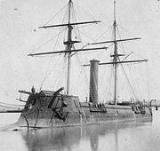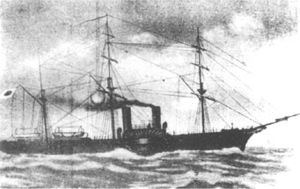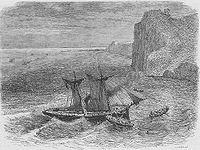
Naval Battle of Miyako
Encyclopedia

Lunar calendar
A lunar calendar is a calendar that is based on cycles of the lunar phase. A common purely lunar calendar is the Islamic calendar or Hijri calendar. A feature of the Islamic calendar is that a year is always 12 months, so the months are not linked with the seasons and drift each solar year by 11 to...
). It was part of the overall Battle of Hakodate
Battle of Hakodate
The was fought in Japan from October 20, 1868 to May 17, 1869, between the remnants of the Tokugawa shogunate army, consolidated into the armed forces of the rebel Ezo Republic, and the armies of the newly formed Imperial government...
at the end of the Boshin War
Boshin War
The was a civil war in Japan, fought from 1868 to 1869 between forces of the ruling Tokugawa shogunate and those seeking to return political power to the imperial court....
.
Preparations
After the remnants of the Bakufu army loyal to the former Tokugawa shogunateTokugawa shogunate
The Tokugawa shogunate, also known as the and the , was a feudal regime of Japan established by Tokugawa Ieyasu and ruled by the shoguns of the Tokugawa family. This period is known as the Edo period and gets its name from the capital city, Edo, which is now called Tokyo, after the name was...
refused to surrender to the new Meiji government in the Battle of Ueno
Battle of Ueno
The Battle of Ueno was a battle of the Boshin War, which occurred on July 4, 1868 , between the troops of the Shōgitai under Shibusawa Seiichirō and Amano Hachirō, and Imperial "Kangun" troops....
and Battle of Aizu
Battle of Aizu
The Battle of Aizu was fought in northern Japan in autumn 1868, and was part of the Boshin War.Aizu was known for its martial skill, and maintained at any given time, a standing army of over 5000. It was often deployed to security operations on the northern fringes of the country, as far north as...
, they fled north to occupy the island of Hokkaidō
Hokkaido
, formerly known as Ezo, Yezo, Yeso, or Yesso, is Japan's second largest island; it is also the largest and northernmost of Japan's 47 prefectural-level subdivisions. The Tsugaru Strait separates Hokkaido from Honshu, although the two islands are connected by the underwater railway Seikan Tunnel...
and established the Republic of Ezo
Republic of Ezo
The ' was a short-lived state established by former Tokugawa retainers in what is now known as Hokkaidō, the large but sparsely populated northernmost island in modern Japan.-Background:...
. The navy of the Imperial forces also moved north to support the eventual invasion of Hokkaidō.
The Imperial navy departed Tokyo
Tokyo
, ; officially , is one of the 47 prefectures of Japan. Tokyo is the capital of Japan, the center of the Greater Tokyo Area, and the largest metropolitan area of Japan. It is the seat of the Japanese government and the Imperial Palace, and the home of the Japanese Imperial Family...
on 1869-03-09, and reached the harbor of Miyako
Miyako, Iwate
is a city located in Iwate, Japan.It was founded on February 11, 1941.The city lies along the coast where the flows into the Pacific Ocean. It is connected to Morioka by an east-west train line and highway and the coastal highway also goes through the town...
, north of Sendai
Sendai, Miyagi
is the capital city of Miyagi Prefecture, Japan, and the largest city in the Tōhoku Region. In 2005, the city had a population of one million, and was one of Japan's 19 designated cities...
, on March 20. The government fleet had been rapidly constituted around the French-built ironclad warship
Ironclad warship
An ironclad was a steam-propelled warship in the early part of the second half of the 19th century, protected by iron or steel armor plates. The ironclad was developed as a result of the vulnerability of wooden warships to explosive or incendiary shells. The first ironclad battleship, La Gloire,...
Kōtetsu, which had been purchased from the United States
United States
The United States of America is a federal constitutional republic comprising fifty states and a federal district...
. Other ships included Kasuga
Japanese warship Kasuga (1862)
was a Japanese wooden paddle steamer warship of the Bakumatsu and early Meiji period, serving with the navy of Satsuma Domain, and later with the fledgling Imperial Japanese Navy.-Service in the Boshin War:...
, Hiryū, Teibo
Japanese warship Teibo
The Japanese warship was a ship of governmental forces during the Boshin war.She was originally built in England and acquired by the fief of Chōshū in western Japan, before being remitted to the new Imperial government in 1868....
, Yoshun, and Moshun
Japanese warship Moshun
was an iron-ribbed, wooden-hulled three-masted schooner with an auxilitary coal-fired steam engine of the Bakumatsu and early Meiji period, serving with the navy of Saga Domain, and later with the fledgling Imperial Japanese Navy.-Service under Saga Domain:...
, which had been supplied by the domains of Saga
Saga Domain
Saga Domain was a han, or feudal domain, in Tokugawa period Japan. Largely contiguous with Hizen Province on Kyūshū, the domain was governed from Saga Castle in the capital city of Saga by the Nabeshima clan of tozama daimyō...
, Chōshū and Satsuma to the new central government in 1868. There were altogether 8 Imperial ships: Kōtetsu, Kasuga, 3 small corvette
Corvette
A corvette is a small, maneuverable, lightly armed warship, originally smaller than a frigate and larger than a coastal patrol craft or fast attack craft , although many recent designs resemble frigates in size and role...
s and 3 transport ships.
Anticipating the arrival of the Imperial fleet, the rebels organized a plan to seize the revolutionary new warship Kōtetsu, and dispatched three warships for a surprise attack:
- KaitenJapanese warship KaitenThe Japanese warship was a warship of the troops loyal to the Shogun during the Boshin War in Japan in 1868. She was armed with 13 cannons, had a complement of 153 men, a displacement of 710 tons, and an engine of 400 hp capable of generating a speed of 12 knots. Her length was 68.4 meters, width...
(flagshipFlagshipA flagship is a vessel used by the commanding officer of a group of naval ships, reflecting the custom of its commander, characteristically a flag officer, flying a distinguishing flag...
of the Republic of Ezo Navy). Kaiten was commanded by Arai IkunosukeArai Ikunosukewas a Japanese samurai of the late Edo period. Prominent as Navy Minister of the Republic of Ezo, he later became famous as the first head of the Japan Meteorological Agency. Also known as or .-Early life:...
, and contained the elite ShinsengumiShinsengumiThe were a special police force of the late shogunate period.-Historical background:After Japan opened up to the West following U.S. Commodore Matthew Perry's visits in 1853, its political situation gradually became more and more chaotic...
, their leader Hijikata ToshizoHijikata Toshizowas the vice-commander of Shinsengumi, a great swordsman and a talented Japanese military leader who resisted the Meiji Restoration.-Background:...
, as well as the former French NavyFrench NavyThe French Navy, officially the Marine nationale and often called La Royale is the maritime arm of the French military. It includes a full range of fighting vessels, from patrol boats to a nuclear powered aircraft carrier and 10 nuclear-powered submarines, four of which are capable of launching...
military advisorMilitary advisorMilitary advisors, or combat advisors, are soldiers sent to foreign nations to aid that nation with its military training, organization, and other various military tasks. These soldiers are often sent to aid a nation without the potential casualties and political ramifications of actually...
Henri NicolHenri NicolHenri Paul Hipolito Nicol was an officer of the French Navy in the 19th century. Based on the ship Minerva of the French Oriental Fleet, he deserted when the ship was anchored at Yokohama harbour, with his friend Eugène Collache to rally other French officers, led by Jules Brunet, who had embraced...
. Nicol had been selected for the attack since he was a native of BordeauxBordeauxBordeaux is a port city on the Garonne River in the Gironde department in southwestern France.The Bordeaux-Arcachon-Libourne metropolitan area, has a population of 1,010,000 and constitutes the sixth-largest urban area in France. It is the capital of the Aquitaine region, as well as the prefecture...
, and knew the characteristics and construction of the revolutionary warship Kōtetsu, built in the same city. - BanryuJapanese warship BanryuThe Japanese warship was a ship of the Bakufu Navy, and subsequently belonged to the troops loyal to the Shogun during the Boshin War in Japan in 1868. Banryū was originally built in England as a schooner, where she had been named Emperor. She had a length of 41.8 meters, a breadth of 5.45 meters,...
, with the elite Yugekitai (遊撃隊) and former French Navy quartermasterQuartermasterQuartermaster refers to two different military occupations depending on if the assigned unit is land based or naval.In land armies, especially US units, it is a term referring to either an individual soldier or a unit who specializes in distributing supplies and provisions to troops. The senior...
ClateauClateauClateau was a French non-commissioned officer of the 19th century, a quarter-master and a cannonry specialist.With the advent of the Boshin War, and the declaration of neutrality of foreign powers, Clateau chose to resign from the French Army and continue the fight on the side of the Bakufu.He...
, in charge of cannonry. - TakaoJapanese steam warship Takaowas a steam warship belonging to the former navy of the Bakufu during the Boshin War of 1868-1869. She had been seized from the navy of the fief of Akita....
(former Aschwelotte) under command of ex-French Navy officer Eugène CollacheEugène CollacheEugène Collache was an officer of the French Navy in the 19th century. Based on the ship Minerva of the French Oriental Fleet, he deserted when the ship was anchored at Yokohama harbour, with his friend Henri Nicol to rally other French officers, led by Jules Brunet, who had embraced the cause of...
, with the elite Shinkitai (伸木隊)].
The ships encountered bad weather, in which Takao suffered from engine trouble, and Banryu became separated. Banryu eventually returned to Hokkaidō, without joining the battle.
Action
To create surprise, Kaiten planned to enter Miyako harbor under an American flag. Unable to achieve more than 3 knots (5.9 km/h) due to engine trouble, Takao trailed behind, and Kaiten first joined battle.Kaiten approached the enemy ships and raised the Republic of Ezo
Republic of Ezo
The ' was a short-lived state established by former Tokugawa retainers in what is now known as Hokkaidō, the large but sparsely populated northernmost island in modern Japan.-Background:...
flag seconds before boarding Kōtetsu. She rammed her prow into the side of Kōtetsu, and started firing her guns. Her deck however proved higher than that of Kōtetsu by close to three meters, forcing the samurai
Samurai
is the term for the military nobility of pre-industrial Japan. According to translator William Scott Wilson: "In Chinese, the character 侍 was originally a verb meaning to wait upon or accompany a person in the upper ranks of society, and this is also true of the original term in Japanese, saburau...
to jump one by one in a trickle. After the first surprise passed, Kōtetsu managed to repel the attack with a Gatling gun
Gatling gun
The Gatling gun is one of the best known early rapid-fire weapons and a forerunner of the modern machine gun. It is well known for its use by the Union forces during the American Civil War in the 1860s, which was the first time it was employed in combat...
, causing huge losses to the attackers. Most of the attacking samurai perished; Nicol was hit by two bullets, and boarding party commander Koga Gengo was killed and his position taken over by Admiral Arai Ikunosuke
Arai Ikunosuke
was a Japanese samurai of the late Edo period. Prominent as Navy Minister of the Republic of Ezo, he later became famous as the first head of the Japan Meteorological Agency. Also known as or .-Early life:...
. In the action, Kaiten damaged three enemy warships, but finally disengaged without having captured Kōtetsu.

Conclusion
The Naval Battle of Miyako was a daring but desperate attempt by the Republic of Ezo forces to neutralize the powerful Kōtetsu. It was the first case of an "abordage" (boardingBoarding (attack)
Boarding, in its simplest sense, refers to the insertion on to a ship's deck of individuals. However, when it is classified as an attack, in most contexts, it refers to the forcible insertion of personnel that are not members of the crew by another party without the consent of the captain or crew...
) maneuver in Japan. Although the attempt ended in failure, the loss of the Takao was marginal. The Imperial Navy continued north unimpeded, and supported the landing and combat of thousands of government troops in the Battle of Hakodate
Battle of Hakodate
The was fought in Japan from October 20, 1868 to May 17, 1869, between the remnants of the Tokugawa shogunate army, consolidated into the armed forces of the rebel Ezo Republic, and the armies of the newly formed Imperial government...
.

